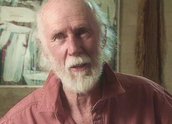


Taking Pictures (1996)
Synopsis
Directors Les McLaren and Annie Stiven interview filmmakers about the ethical questions and issues of representation raised when filming Papua New Guinean and other cultures. Taking Pictures features clips from many Australian ethnographic documentaries filmed in PNG.
Curator’s notes
Taking Pictures questions the thoughts and actions of Australian ethnographic filmmakers who worked in Papua New Guinea between the early 1970s and the mid-‘90s. The documentary also includes interviews with two PNG filmmakers who reflect on their own experience of interpreting film and culture. All of these filmmakers capture the energy and contradictions of a country in transition.
Narrator Les McLaren asks, ‘No matter how well intentioned, can we really see another society other than through our own cultural lens?’. Australian filmmakers are interviewed about their past experiences in PNG and the many issues that arise in filming another culture: ethical considerations, representing other cultures, respecting the subjects and the material gathered, having indigenous people speak for themselves, and the importance of capturing local languages, ceremonies, plays, mythology and symbols before they are lost.
In the time that these filmmakers were making their films, the world was changing. They were able to capture on film important ceremonies, the enormous transformation that was happening in PNG and the integrating of Western and PNG cultures (see clip one).
What interested Bob Connolly and the late Robin Anderson most about making Joe Leahy’s Neighbours (1988) was Joe Leahy’s position, his relationship with key members of the Ganiga tribe and the forces at work. In speaking about their experiences in PNG, Anderson really puts her finger on what it’s like working on observational films in the field (see clip two).
The documentaries feature breathtaking footage from local ceremonies, some of which go on for hours or even days. It is a difficult and sensitive task to cut the ceremonies down to make a 60 or 90-minute film and do the ceremony justice. Ian Dunlop was asked to film a Baruya ceremony and worked closely with the elders to precisely document it. He ended up working more than ten years to produce two versions of the footage (see clip three).
Taking Pictures contains clips from some of the most internationally renowned Australian documentaries, including Towards Baruya Manhood (1972), Trobriand Cricket: An Ingenious Response to Colonialism (1976), The Sharkcallers of Kontu (1982), First Contact (1983), Cannibal Tours (1987), Joe Leahy’s Neighbours (1988), Man Without Pigs (1990) and Black Harvest (1992). It also features films from indigenous PNG filmmakers: Stolat (1985), by Pengau Nengo, Martin Maden and Bike Johnston, and Sinmia (1985), by Kumain Kolain.
- Overview
- Curator’s notes
- Video 3 clips
- Principal credits
- Find a copy
- Make a comment
- Map
- Add your review



